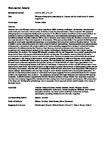Pliocene stratigraphic paleobiology in Tuscany and the fossil record of marine megafauna
| dc.contributor.author | Dominici, S | en |
| dc.contributor.author | Danise, S | en |
| dc.contributor.author | Benvenuti, M | en |
| dc.date.accessioned | 2017-12-12T16:33:21Z | |
| dc.date.available | 2017-12-12T16:33:21Z | |
| dc.date.issued | 2018-01 | en |
| dc.identifier.issn | 0012-8252 | en |
| dc.identifier.uri | http://hdl.handle.net/10026.1/10408 | |
| dc.description.abstract |
Tuscany has a rich Pliocene record of marine megafauna (MM), including mysticetes, odontocetes, sirenians and seals among the mammals, and six orders of sharks among the elasmobranchs. This is reviewed with respect to paleogeography and sequence-stratigraphy in six different basins. Conditions at the ancient seafloor are explored by means of sedimentary facies analysis, taphonomy and multivariate techniques applied to a large quantitative dataset of benthic molluscs. MM is rare or absent in most basins during the Zanclean, except in one basin, and most abundant in Piacenzian deposits in all six basins. MM occurs preferentially in fine-grained, shelfal highstand-deposits of small-scale depositional sequences, or at condensed horizons of the maximum flooding interval. It is rare in shallow marine paleonvironments and nearly absent in bathyal paleosettings. Paleogeographic and paleoecological evidence and a comparison with modern patterns of marine upwelling suggest that a wedge of nutrient-rich waters sustained in the offshore during the Pliocene a high biomass of primary producers and a community of apex consumers and mesopredators, similarly to the modern northwestern Mediterranean Sea, with a species-richness higher than the modern and a more complex trophic structure. The highest MM diversity coincides with the mid-Piacenzian warm period, suggesting that facies control does not obscure a link between climate and diversity. We underline however that not all marine environments were suitable for marine mammal preservation. Buoyant carcasses were preferentially dismembered and destroyed in high-energy shallow waters, with the possible exception of delta front deposits, where sudden sediment input occasionally buried pristine carcasses. We hypothesise that carcasses sunken on the seafloor below the shelf break underwent destruction through the activity of a whale-fall biota of modern type, specialised in the consumption of decomposing tissues, both soft and mineralised. A taphonomic window was left between storm wave base and the shelf break. Here water pressure is high enough to prevent the formation of decomposing gases and the resurfacing of carcasses, while the lack of a specialised whale-fall biota slows down bone degradation with respect to deeper settings. Sedimentation rate was high enough to cover skeletal material before its complete destruction. An estimate of paleobathymetries based on multivariate techniques suggests that the preferential depth for the inclusion of MM in the fossil record was 30–300 m. The results are compared with major Mesozoic and Cenozoic MM records worldwide. Available evidence suggests that the late Neogene radiation of large whales, true ecosystem engineers, and their size increase, triggered the radiation of a bone-eating fauna that hampered, and hampers, MM preservation in the deep sea. Stratigraphic paleobiology and an ecosystem-level approach deliver useful insights to the nature of the fossil record. | |
| dc.language.iso | en | en |
| dc.publisher | Elsevier | en |
| dc.title | Pliocene stratigraphic paleobiology in Tuscany and the fossil record of marine megafauna | en |
| dc.type | Journal Article | |
| plymouth.publication-status | Published | en |
| plymouth.journal | Earth-Science Reviews | en |
| dc.identifier.doi | 10.1016/j.earscirev.2017.09.018 | en |
| plymouth.organisational-group | /Plymouth | |
| plymouth.organisational-group | /Plymouth/Faculty of Science and Engineering | |
| plymouth.organisational-group | /Plymouth/Faculty of Science and Engineering/School of Geography, Earth and Environmental Sciences | |
| dcterms.dateAccepted | 2017-09-22 | en |
| dc.rights.embargodate | 2018-09-28 | en |
| dc.rights.embargoperiod | Not known | en |
| rioxxterms.versionofrecord | 10.1016/j.earscirev.2017.09.018 | en |
| rioxxterms.licenseref.uri | http://www.rioxx.net/licenses/all-rights-reserved | en |
| rioxxterms.licenseref.startdate | 2018-01 | en |
| rioxxterms.type | Journal Article/Review | en |


